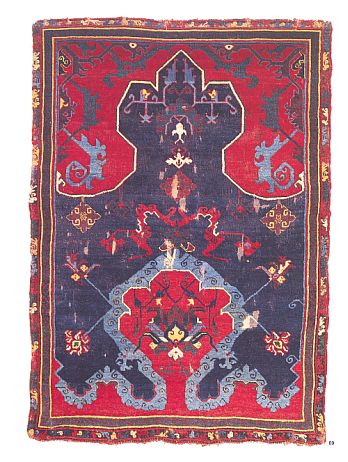Posted by Wendel Swan on 07-19-2007 01:18 PM:
A must see before this ends
Hello all,
I know that this salon is about to close. Many beautiful
and historic rugs and kilims have been shown, but I've been surprised at how
little comment some of the greatest have received.
One of my favorite
rugs anywhere is this one with an 8-lobed medallion, Holbein-type roundels,
squinches and a cloudband border. The purple ground of the medallion is
stunning.

When I first saw this rug in the old Vakiflar it was hanging
horizontally in an old stariway, barely visitble in the dim light. It was a
delight to see this old friend cleaned and hanging in the proper
orientation.
ICOC-XI is now past but those who manage a visit to Istanbul
can see this and other wonderful weavings at the Vakiflar and the TIEM.
I
have an earlier image of it on my coffeee mug, so I see it every day. I never
fail to admire it, so I couldn't let comments on ICOC-XI without letting others
have the privilege.
Wendel
Posted by Patrick Weiler on 07-20-2007 12:50 AM:
Send it to me, please
Wendel,
There are a few rugs that I would be willing to give away my
entire collection for and this would easily be one of them. (Some folks would
say that it would not be much of a sacrifice)
That lively outer border is
literally crawling with clouds. The anthropomorphic figures on the yellow ground
in the central medallion appear to be floating away from the center of the
medallion. The corner spandrels reinforce this outward motion, imparting a sense
of tranquil expansion.
And are those magic yellow mushrooms in the roundels
at the top and bottom of the field?
I think they were onto something way back
then.
Patrick Weiler
Posted by R. John Howe on 07-20-2007 08:41 AM:
Wendel -
Thanks for attracting attention to this piece. One problem
with the mode in which we usually saw most of the pieces at ICOC XI (that is,
during a reception) was that sometimes one experienced input overload in which
the senses were literally flooded with material. In that circumstance, even a
great piece like this can get "buried" in a way.
About the lack of
comment on some of this high quality older material: it is often not clear what
can be said usefully. Some of this older material seems to require a level of
knowledge for intelligent comment that most of us (I definitely include myself)
simply don't have. The comparative comments in the Transylvanian catalog often
draw on a knowledge of similar pieces worldwide. Lacking that, the best most of
the rest of us can do is to describe what we see and to make more accessible
comparisons. I'll attempt both of those things below.
The brilliance of
the colors here are noteworthy. Color selection also seems very skillful. You
point out how effective the use of purple is. The range of color is wide enough
to produce real richness of perception.
Notice how this piece compares
with the Bode rug I put up in the Transylvanian salon. Here are the images again
for close comparison.


As
good as the Bode piece is (and I think its graphics and color saturation are
superior) I think this piece you offer here is better. This may, in part, be to
a somewhat more complex design that offers more points of interest in it, but,
for me, I think it is importantly a matter of the richness that its range of
color projects.
Regards,
R. John Howe
Posted by Wendel Swan on 07-20-2007 09:06 AM:
Hi John,
I saw the Bode rug (rather small) for the first time in the
wool in Paris in February and it was better than I expected. Couldn't get a
decent picture of it though. Guards kept me at bay.
Wendel
Posted by Jerry Silverman on 07-20-2007 01:37 PM:
Squiches?
Curiously,
-Jerry-
Posted by R. John Howe on 07-20-2007 01:48 PM:
Hi Wendel -
You mention in part in your post above that the "Bode" rug
I have introduced here seemed "rather small" when you saw it in
Paris.
Say more about that.
The Bode rug is 120 x 180 cm. It is
fragmented at its edges, and so was a little larger, but seems to be about the
same size as most of the the western Anatolian pieces from which those in the
"Transylvanian" exhibition were drawn.
"Rather small" in relation to
what?
I'm not sure I've heard pure size offered as a seeming criticism
before.
Regards,
R. John Howe
Posted by Richard Larkin on 07-20-2007 06:37 PM:
Wendel,
Regarding the sparse comment on this wealth of wonderful rugs
(including the middle-wonderful ones), I agree with John that the volume is
somewhat overwhelming, and the material speaks for itself anyway, in a way. I
will certainly be glad to hear anything authoritative that can be said about
this stuff.
Regarding the purple, do you happen to know how this color
was produced? I assume it is from the same dye source and method that many older
(through the 19th century) Turkish rugs that had a superior purple utilized.
__________________
Rich
Larkin
Posted by R. John Howe on 07-20-2007 08:27 PM:
Hi Jerry -
I know you for a Peter Stone fan and are no doubt sitting
close to a copy of his "Lexicon."
Wendel is not being obscure. On page
213 Stone says:
"squinch"
"One of four arches thrown across
corners of a square or octagonal room to create a zone of transition on which a
dome may then be created."
Although even Stone doesn't say so,
specifically, I think this architectural term is sometimes used in rug
literature to describe what we also call "corner brackets."
Wendel will
confirm or correct me.
Regards,
R. John Howe

